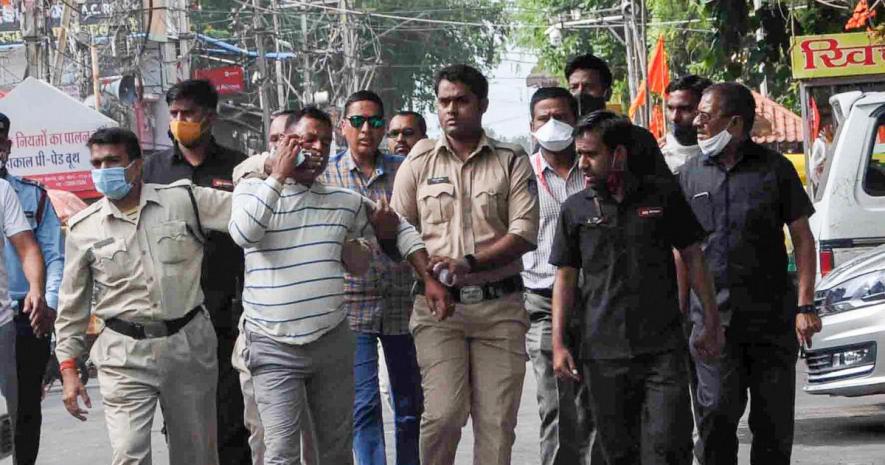Why Sensational Shoot-outs Won’t Make Gangs Disappear

Image Courtesy: PTI
Notorious gangster Vikas Dubey has been liquidated in Kanpur. Will the Uttar Pradesh model of tackling the underworld send a message of no-tolerance to criminal gangs across the country? Many would have us believe it will, but recent events show that is not the case.
In Jamshedpur, Jharkhand’s steel city, the underworld is still making news. City gangster Akhilesh Singh was nabbed by Jamshedpur Police in Gurugram, Haryana, in 2017, and sent to Dumka jail. But after a gang war erupted in the steel city on 29 April the police are back to hunting for Harish Singh, one of Akhilesh’s sharpshooters. Akhilesh’s story is emblematic of the lives of Indian gangsters in the post-liberalisation era, which includes Vikas Dubey, who became active in the 1990s. The media may portray gang-driven crimes as a sensational but aberrant phenomenon, but gangsters are produced by circumstances—the question is, how and when will they perish?
Right now, the gangs of North India only seem to be shifting loyalties, not disappearing into oblivion. On 11 July, it was reported that some Akhilesh minions are migrating to other gang-lords such as Sudhir Dubey and Krishna Rao (from Kadma, a locality of Jamshedpur city) and Saifuddin (from nearby Adityapur). Incidentally, Sudhir Dubey was once an associate of Akhilesh, though they are now rivals. Most gang rivalries in this part of India are over railway contracts and the rangdari or extortion “business”. This is also true of gangs in Gorakhpur and Mirzapur in eastern Uttar Pradesh and Muzaffarpur in North Bihar.
And it is not just these gangs. The Paramjit Singh ring, led by Kartik Munda and Manoj Sarkar, are also said to be gearing up to challenge Akhilesh while he is in lock-up. Reports from Jharkhand indicate that these realignments are driven by the ambition for supremacy in the Kolhan Division of Jharkhand. The Saraikela police claim to have confessions and evidence from the associates of Kartik and Manoj that confirm plans to extort businessmen. This became evident during the recent shoot-out and bomb explosion.
Another strong signal that gangs are thriving is the recent death threat received by Jharkhand Chief Minister Hemant Soren. Rivalries are not new in the world of gangsters. The lockdown and the Covid-19 pandemic have shaken the economic base of these gangs, but this has only renewed their offensives to capture each others’ territories.
Jamshedpur’s political economy and its underworld
MJK Sahlin’s Jamshedpur and Patna developed into cities in the early 20th century. Jamsetji Tata discovered the richest mineral area of the subcontinent in the Chhotanagpur plateau of then South Bihar and established the Tata Iron and Steel Company or TISCO in 1907, where production began in 1913. It currently has around 78,000 employees.
In 1945, the Tatas established a Tata Engineering and Locomotive Company or TELCO unit (now Tata Motors Limited), which has 10,000 employees, at another township on the southeastern corner of Jamshedpur. Small-scale ancillary units sprang up in the contiguous small towns of Adityapur, Gamharia and elsewhere, also employing large numbers of people. By the early 1990s, the steel- scrap auctioned by TISCO had an impressive annual turnover of Rs.200 crore. Gang wars in this region emerged in the previous decade, primarily to wrest control over these auctions.
An illustration is the “Steel Don” Hedayat Khan, son of a wealthy fruit merchant in Jamshedpur who became notorious in the late 1980s, having claimed a friend as his first victim. It is said that he disapproved of his friend’s attraction for his sister, on caste grounds. After he joined the steel-scrap trade, he eliminated two rival gangs headed by Sanjay Singh and Kaalu Singh. In June 1990, during a scrap auction inside the TISCO premises, his men opened fire at Birendra Singh, leader of the “Garam Nala” gang, killing three. Not a single accused was arrested. Khan then took to roaming Jamshedpur in a Maruti Gypsy, his men brandishing guns to demonstrate his power.
Birendra, Hedayat and a third gangster, Anand Rao, also fought over contracts for slag-dumping, the Suvarnarekha River Project and Railway bids. The 2007 book, Bihar Through the Ages, edited by SR Bakshi and Ritu Chaturvedi, details the political patronage these strongmen got. On 8 August 1987, the Jharkhand Mukti Morcha leader Nirmal Mahto was killed inside a TISCO guest house. Stephen Marandi, a JMM legislator from Dumka at the time, himself claimed that Birendra and Mahto were rivals vying for the Suvarnrekha project.
In 1994, TISCO general manager JJ Irani appealed to then chief minister Lalu Yadav to take on Jamshedpur’s gangsters. Irani feared for his life, and for the survival of the Tata empire. His fears were neither unfounded nor exaggerated. There had been a series of high-profile killings in the city—the ruling Janata Dal’s Thakurji Pathak, the transporter Sona Singh and TP Singh, president of the transporters’ association. TISCO’s management had discerned a pattern: all three victims were engaged in the scrap trade. Besides, the city’s criminals were routinely graduating to contracting and thereafter joining politics. The politco-crime nexus was eliminating any roadblocks, even high-ranking TISCO managers. TA Gobba, SN Sahay and Prabhat Kumar were three such victims. But it is the killing of VG Gopal, president of the Tata Workers’ Union, that really shook the city and Tata workers.
Gopal was considered as powerful as the TISCO chief in Jamshedpur. In a newly-liberalised economy, he also was the last impediment to the casualisation and retrenchment of labour. Andrew Sanchez’s 2016 book, Criminal Capital, suggests that the union leader was an eyesore even within the company. Dilip Simeon’s 1995 book, The Politics of Labour Under Late Colonialism, 1928-39, throws light on this murky past. For instance he refers to 20 September 1931, the day labour leader Subhash Chandra Bose was violently attacked by hooligans, allegedly hired by the Tatas.
Assassinations and gang-wars were also triggered by rival criminals seeking to curry favour with the Tatas. Ironically, casualisation and retrenchment of workers increased in the liberalised era, and expanded the base of recruitment for gangsters, which made the company more insecure.
Lalu then conducted an administrative overhaul: in 1994, the Superintendent of Police, Parvez Hayat, was replaced by Ajoy Kumar. In 1996 Kumar joined Tata Motors in Pune and thereafter entered politics. He represented Jamshedpur in the Lok Sabha on the Jharkhand Vikas Morcha symbol. He then hopped on to the Congress bandwagon and was its Jharkhand chief until 2019. It is said that Kumar had brought down the crime rate in Jharkhand. In 2011, it was reported that he had supervised around two dozen “encounters”. Yet Kumar could not nab the sharpshooter who had killed Gopal, a crime whose eyewitness was the news reporter Ashit Biswas.
The late 1970s as the beginning of gangsterism in small towns:
Gangsterism rose in the 1970s in non-mega cities and small towns, with the “underworld” phenomena prominent in the Purvanchal region of Uttar Pradesh, mainly Gorakhpur and Mirzapur, Muzaffarpur in North Bihar, and Jamshedpur and Dhanbad in South Bihar (now Jharkhand). After the Green Revolution and despite limited land reforms, newly-affluent rural elites, typically the better-off among the backward sections, thronged to urban India seeking modern education and jobs. By the eighties they coveted political power as well.
This assertion of rural elites and the resistance to it made these turbulent decades filled with political instability. Governments in Bihar those days were run more through ordinances than legislation. Those heydays of gangsterism are what Atul Kohli calls the “revolution of rising expectations” in his book, Democracy and Discontent.
The social composition of campuses had started changing in the late 1960s, the period of Naxalism in parts of Bihar. The state simultaneously experienced caste conflicts on campuses and massacres of landless workers. In 1978, the Mungerilal Report was implemented, reserving seats for backward classes and women in public employment and educational institutions, which further democratised campuses. Ragging was an early manifestation of resistance to this. PN Gour’s 1984 book, Student Unrest in the Universities of Bihar, 1967-1972, asserts the caste basis of these disturbances.
However, gangs did not undergo such liberalisation. Gangsters were almost entirely drawn from the upper castes, mainly Rajputs and Bhumihars, and some Muslims. This only changed in the 1990s, when the backward classes became political elites in Bihar. So Brij Bihari rose in Muzaffarpur against Bhumihar gangsters, mainly the Shukla brothers. It is said that the Bhumihar “lord” of Muzaffarpur, Raghunath Pandey, a transport and cinema entrepreneur, patronised Brij Bihari in his student days. Similarly, in Bihar’s Koilwar region, the sand mafia dominated by the Rajputs also shifted into Yadav control in the Lalu era.
The crime lords in Jamshedpur can be viewed through the caste prism too. For one, Akhilesh was not just a policeman’s son but also a Rajput. Members of his caste in the police tended to look the other way as he built his empire, the “A-Company”—A for Akhilesh. Besides, the techno-managerial positions in the Tatas were occupied largely by Bengalis or South Indian elites, and as Andrew Sanchez elaborated in 2016, stereotypes about Biharis were generated and circulated widely at this time. This squeezed the Bihari elite into the steel-scrap trade, which became a medium for their climb up the economic and social ladder.
Triple murder sensation of Jamshedpur:
On 2 February 1989, three men were gunned down at the Jugsalai Power House at Jamshedpur; Congress leader Pradip Mishra, a criminal who aspired to join politics named Janardan Chaubey and gang leader Anand Rao. It is said that Birendra Singh had hired two shooters, Ramashankar Singh from Vaishali and Shahabuddin from Siwan, to execute them. Shahabuddin was seen as the one to safeguard Rajput landlord interests against the ultra-Left, while Ramashankar and Birendra are Rajput.
The same Shahabuddin became MLA twice in the 1990s and entered Parliament in 1996 and then won three more consecutive terms. Ramashankar became Lok Janshakti Party legislator and defeated the sitting Member of Parliament Raghuvansh Prasad Singh in 2014. Soon after he entered the Lok Sabha, Ramashankar was jailed in a kidnapping case in Raipur, Chhattisgarh. But he was exonerated in the triple murder case in 2006 (and Shahabuddin in 2017). Three murders in broad daylight at a busy marketplace in a city could not get justice. It was as if nobody had killed them.
Why extortion is a most-favoured crime:
Jamshedpur did not see extortion cases until Jharkhand gained statehood. Sanchez says extortion grew due to casualisation of labour under the neo-liberal economic order, particularly after the elimination of labour leader Gopal in October 1993. As youth unemployment surged, the young were more easily available as recruits into crime. David Arnold, in his 1979 essay, “Dacoity and Rural Crime in Madras 1860-1940”, says that crime was a frequent and widespread response during famines and periods of high inflation.
Crime also symbolises the attempts of a declining elite to maintain or regain their pre-eminence. Suranjan Das has argued that at particular historical junctures “crime becomes politics—it can be a prologue to conscious and articulate resistance by the dispossessed”. Further, during the run-up to the nineties and thereafter, the capitalist class (including the Tatas) had strengthened themselves. Criminals could no longer outsmart them. Kidnapping for ransom was one of the diversifications adopted by gangs. Akhilesh also entered the real estate business, and some of his properties were seized by police in 2016.
In 2014, Akhilesh joined AJSU, which was celebrated with life-size hoardings across Jharkhand’s busy roads. Also in prison at the time, he secured bail (à la Vikas Dubey), but was banned from Jamshedpur. He moved to Ranchi where he floated the Jharkhand Kshatriya Sangh and continued his extortion racket. Though under arrest again since 2017, he is known to be operating his crime syndicate.
To think that killing Vikas Dubey, no matter how spectacularly, would deter gangsters would be foolhardy. After all, imprisonment does not stop them. The answers lie in finding answers to how petty criminals grow strong enough to overpower the police and justice systems, enough to become legislators. In “Village Crime Note-Books”, Suranjan Das and Basudeb Chattopadhyay have studied the police event diary for a thana in Malda, West Bengal, for the period 1920 to 1970. Such historical explorations will be much more relevant fighting crime than sudden outbursts in the form of “encounters”.
Mohammad Sajjad teaches modern and contemporary Indian history at AMU and Zeeshan Ahmad is studying law at AMU. The views are personal.
Get the latest reports & analysis with people's perspective on Protests, movements & deep analytical videos, discussions of the current affairs in your Telegram app. Subscribe to NewsClick's Telegram channel & get Real-Time updates on stories, as they get published on our website.
























